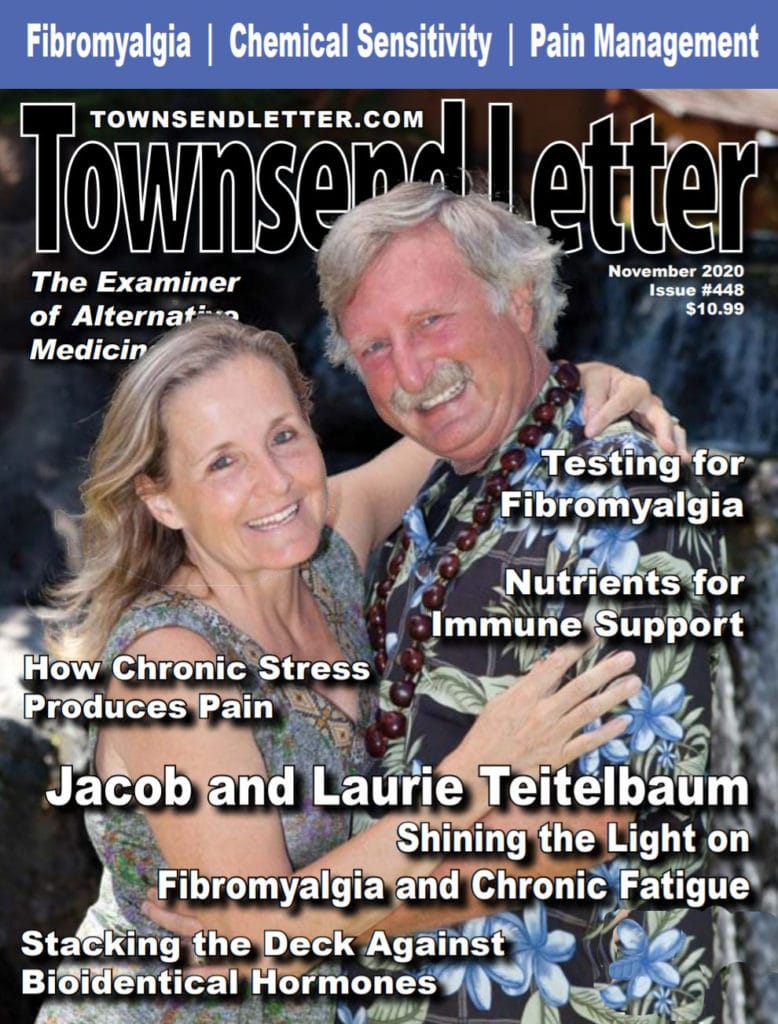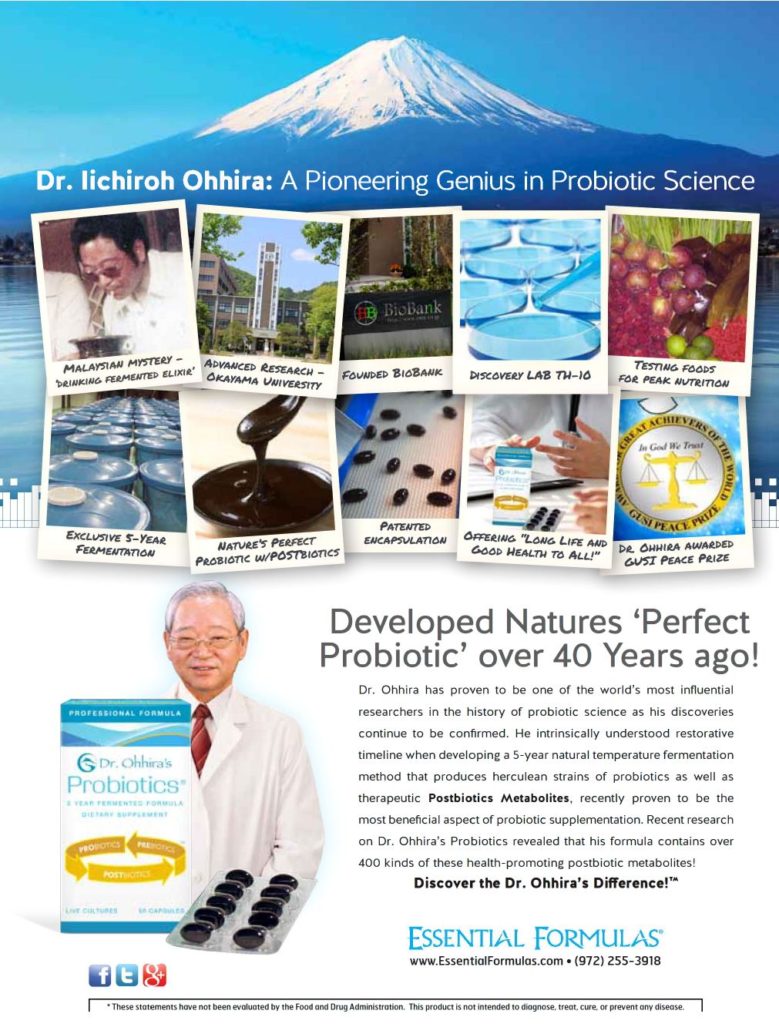…article continued:
Cytokine testing may be a consideration for FM patients, especially those unresponsive to treatment. A finding of elevated cytokines may help confirm the inflammatory nature of the condition but should also prompt further investigations to rule out possible autoimmune disease or other causes. Cytokine biomarkers can be used to determine the level of inflammation, monitor progress as well as individualize a patient’s treatment plan. Accuracy of testing may vary depending on multiple factors: stage of the disease, timing of the test (cytokine release is episodic), location of inflammation, etc. For example, TNFa has a peak plasma concentration of two hours with a half-life of 18.2 minutes after exposure to an initiating substance and IL-6 levels are biphasic with peaks at 6 and 74 hours.35 Also, cytokine levels may differ between body fluids, i.e. some patients with neuropsychiatric disorders have higher cytokine levels in CSF vs. serum, depending on the integrity of the blood brain barrier.36 Still, there is value in testing, especially when evaluating the broader picture of multiple biomarkers. Cytokine panels are offered by a variety of labs, including Arup Lab (13 cytokine panel) and Life Extension (4 cytokine panel) while Labcorp and Sonora Quest only offer individual tests for each specific cytokine.
In practice, dietary intervention is a core therapeutic approach for all my autoimmune and FM patients. I find that it is very difficult to address complicated patients without dietary changes, particularly eliminating food sensitivities and increasing vegetable intake. Typically, IgG food sensitivity testing is performed, or I recommend a strict elimination diet of nine days, followed by a re-introduction phase of a new food every three days eaten repeatedly. If any reaction occurs, the offending food is removed immediately, and a new food is not re-introduced for two-to-three days or until symptoms resolve. A modified Whole 30 or Paleo diet can be beneficial as an alternate plan. Patients are instructed to avoid pork and red meat and are told to systematically introduce eggs and almonds, common reactive foods, after avoidance for 10 days.
Depending on the patient, other investigations that may be considered include testing and treatment for adrenal function, gut dysbiosis, environmental toxicity, infections or
cytokines, as indicated. Common prescriptions include a modified IV Myer’s cocktail weekly for four weeks (includes ascorbic acid 12.5 grams and MgCl 3-5 cc) or an IV magnesium push (MgCl 3 cc, 7 cc sterile H20) as an alternative. Sleep is a key issue and must be addressed. SAMe at a dosage of 400 mg twice daily can be very effective for pain reduction, sleep, as well as improve depression.28 Otherwise, I may recommend melatonin 3 mg or 5-HTP 100 mg, which improves both sleep and symptoms of FM.37, 38 Low dose naltrexone may be prescribed at bedtime, 1.5 mg and titrated up every two weeks to 4.5 mg. While it can be very helpful for the pain, intense dreams can occur initially, and compliance may become an issue.
Fibromyalgia is a complex condition with multiple causative factors. The approach should depend on each individual patient, their signs and symptoms, as well as history. The dysfunction may occur at many different levels including, but not limited to, cellular, neuroendocrine, and immune. Diagnostic testing may be helpful but has limitations. Inflammation appears to play an important role in the presentation and severity of FM and should be one of the considerations in designing an effective therapeutic plan.
References
- Wolfe F, et. al. Revisions to the 2010/2011 Fibromyalgia Diagnostic Criteria. Arthritis Rheum. 2016;68 (supp 10)
- Wolfe F, Schmulkler J, Castrejon I. Diagnosis of Fibromyalgia: Disagreement Between Fibromyalgia Criteria and Clinician‐Based Fibromyalgia Diagnosis in a University Clinic. Arthritis Care Research. 2019 Mar;71(3):343-351
- Behm FG, et. al. Unique immunologic patterns in fibromyalgia. BMC Clin Path. 2012, Dec 17;12:25
- Wallace DJ, et. al, Cytokine and chemokine profiles in fibromyalgia, rheumatoid arthritis and systemic lupus erythematosus: a potentially useful tool in differential diagnosis. Rheumatol Int. 2015, 35:991–996
- Cerdá-Olmedo G, et.al. Identification of a microRNA signature for the diagnosis of fibromyalgia. PLoS ONE. 2015, 10(3)
- Bjersing JL, Bokarewa MI, Mannerkorpi K. Profile of circulating microRNAs in fibromyalgia and their relation to symptom severity: An exploratory study. Rheumatol Int. 2015, 35, 635–642
- Masotti A, et. al. Circulating microRNA Profiles as Liquid Biopsies for the Characterization and Diagnosis of Fibromyalgia Syndrome. Mol Neurobiol. 2017;54: 7129–7136.
- Dai A, et. al. The Regulatory Mechanisms and Therapeutic Potential of MicroRNAs: From Chronic Pain to Morphine Tolerance. Neurosci. 2018; 11: 80.
- Bjersing JL, et. al. Profile of cerebrospinal microRNAs in fibromyalgia. PLoS One. 2013 Oct 25;8(10)
- Fatima G, et. al. Lack of circadian pattern of serum TNF-alpha and IL-6 in patients with fibromyalgia syndrome. Indian J Clin Biochem. 2012;27:340–343.
- Wallace DJ, et.al., Cytokines Play an Aetiopathogenetic Role in Fibromyalgia: A Hypothesis and Pilot Study. Rheumatology (Oxford). 2001 Jul;40(7):743-9.
- Bazzichi L, et al. Cytokine patterns in fibromyalgia and their correlation with clinical manifestations. Clin Exp Rheumatology. 2007: 25;225–30
13. Buyukkose M, et. al. Seroprevalence of parvovirus B19 in fibromyalgia syndrome. Clin Rheum. 2009 Mar;28(3):305-9
14. Krumina A, et al. The role of HHV-6 and HHV-7 infections in the development of fibromyalgia. J Neurovirol. 2019 Aug;25(4):617
15. Akkaya N, Akkaya S, Polat, Y. Helicobacter Pylori Seropositivity in Fibromyalgia Syndrome. Clin Rheumatol. 2011 Jan;30(1):43-9.
16. Willams M, et. al. Epstein-Barr Virus dUTPase Induces Neuroinflammatory Mediators: Implications for Myalgic Encephalomyelitis/Chronic Fatigue Syndrome. Clin Ther. 2019 May;41(5):848-863.
17. Wittrup IH, et. al. Comparison of viral antibodies in 2 groups of patients with fibromyalgia. .J Rheumatol. 2001 Mar;28(3):601-3.
18. Douche-Aourik F, et al. Detection of enterovirus in human skeletal muscle from patients with chronic inflammatory muscle disease or fibromyalgia and healthy subjects. J Med Virol. 2003 Dec;71(4):540-7.
19. Lichtenstein JHR, et. al., Environmental Mold and Mycotoxin Exposures Elicit Specific Cytokine and Chemokine Response. PLoS One. 2015; 10(5)
20. Gruzieva O, et. al. Exposure to Traffic-Related Air Pollution and Serum Inflammatory Cytokines in Children. Environ Health Perspect. 2017 Jun; 125(6): 067007.
21. Parkitny L, Younger J. Reduced Pro-Inflammatory Cytokines after Eight Weeks of Low-Dose Naltrexone for Fibromyalgia, Biomedicines. 2017 Apr 18;5(2):16
22. Younger, J, Mackey S, Fibromyalgia Symptoms Are Reduced by Low-Dose Naltrexone: A Pilot Study. Pain Medicine. May 2009;10(4): 663–672.
23. Cordero M, et al. Can Coenzyme q10 Improve Clinical and Molecular Parameters in Fibromyalgia? Antioxid Redox Signal. 2013 Oct 20;19(12):1356-61.
24. Abodollahzad H, et al. Effects of Coenzyme Q10 Supplementation on Inflammatory Cytokines (TNF-α, IL-6) and Oxidative Stress in Rheumatoid Arthritis Patients: A Randomized Controlled Trial. Archives of Medical Research. October 2015:46(7): 527-533
25. Fan Li, et. al. Effects of Coenzyme Q10 Supplementation on Inflammatory Markers: A Systematic Review and Meta-Analysis of Randomized Controlled Trials. Pharmacol Res. 2017 May;119:128-13626. Rossini M, et. al. Double-blind multicenter trial comparing acetyl l-carnitine with placebo in the treatment of fibromyalgia patients. Clin Exp Rheumatol. 2007 Mar-Apr;25(2):182-8.
27. Kouttab NM, Simone C. Modulation of cytokine production by carnitine. Mediators Inflamm. PLoS One. 1993; 2(7): S25–S28.
28. Jacobsen S, Danneskiold-Samsøe B, Andersen RB. Oral s-adenosylmethionine in primary fibromyalgia. Double-blind clinical evaluation. Scand J Rheumatol. 1991;20:294–302.
29. Pfalzer AC, et. al. PS-adenosylmethionine mediates inhibition of inflammatory response and changes in DNA methylation in human macrophages. Physiologic Genomics.Sept 2014; 46(17)
30. Correa-Rodriguez M, et. al. The Association of Body Mass Index and Body Composition with Pain, Disease Activity, Fatigue, Sleep and Anxiety in Women with Fibromyalgia. Nutrients. 2019 May; 11(5): 1193.
31. KirchgessnerTG, et. al. Tumor Necrosis Factor-a Contributes to Obesity-related Hyperleptinemia by Regulating Leptin Release from Adipocytes. J Clin Invest. 1997 Dec 1; 100(11): 2777–2782.
32. Tian D, et. al., High Fat Diet Sensitizes Fibromyalgia-Like Pain Behaviors in Mice via Tumor Necrosis Factor Alpha. PLoS One. 2018 Feb; 14;13(2)
33. Dias Batista ED, et. al. Food intake assessment and quality of life in women with fibromyalgia. Rev Bras Reum Engl Ed. 2016;56: 105–110
34. Silva AR, et. al. Dietary interventions in fibromyalgia: a systematic review. Annals of Medicine. 2019;51(sup1):2-14.
35. Brocco M, et. al. A study of interleukin 6 (IL-6) and tumor necrosis factor alpha (TNF-α) serum levels in rats subjected to fecal peritonitis and treated with intraperitoneal ropivacaine. Acta Cir Bras. July 2012;27 (7).
36. Lepennetier G, et. al. Cytokine and immune cell profiling in the cerebrospinal fluid of patients with neuro-inflammatory diseases. J Neuroinflammation. Nov 2019.
37. Hemati K, et. al. Melatonin in the treatment of fibromyalgia symptoms: A systematic review. Complement Ther Clin Practice. February 3, 2020.
38. Caruso I, et al. Double-blind study of 5 hydroxytryptophan versus placebo in the treatment of primary fibromyalgia syndrome. Int Med Res. 1990 May-Jun;18(3):201-9








